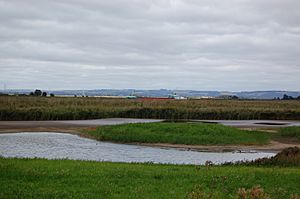Blacktoft Sands RSPB reserve facts for kids
Blacktoft Sands RSPB reserve is a special nature spot in East Riding of Yorkshire, England. It's a place where you can see amazing wildlife, especially birds. The Royal Society for the Protection of Birds (RSPB) looks after this reserve. They rent the land from Associated British Ports.
About Blacktoft Sands
Blacktoft Sands is a wetland area. This means it's a place where the land is often covered in water, like a marsh. It sits on the south side of the River Ouse. This is close to where the Ouse meets the River Trent. The water here is a little bit salty. This is because it's at the start of the Humber Estuary. An estuary is where a river meets the sea.
The reserve has England's biggest reedbed that gets affected by tides. A reedbed is an area full of tall grass-like plants called reeds. The RSPB manages this area carefully. They use six konik horses to graze the land. They also cut reeds and dig new pools to help the wildlife.
Amazing Wildlife
Blacktoft Sands is famous for its many birds. You can spot wetland birds that are quite rare in Britain.
Birds to Spot
Some birds that nest here are reedbed specialists. These include the Western marsh harrier, great bittern, and bearded reedling. The pied avocet prefers the salty lagoons.
In winter, you might see the Hen harrier. Other winter visitors include merlin, peregrine falcon, and barn owl. Large numbers of Eurasian teal and Eurasian wigeon also spend their winters here.
The great bitterns first nested here in 2000. The pied avocets started nesting in 1992. Now, the Humber area has important groups of these birds. The whole Humber Estuary is important for many types of wading birds and wildfowl. You might also see birds passing through, like the Eurasian spoonbill, spotted redshank, and ruff.
Tiny Creatures
The lagoons are also home to some rare small creatures. These include tiny amphipods like Gammarus insensibilis and Gammarus chevreuxi. You can also find a type of fly called a chironomid, specifically Glyptotendipes barbipes.


